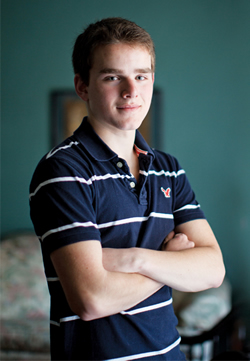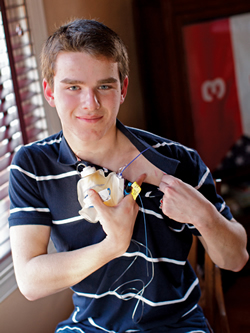Advanced anesthesia technique eases shoulder surgery for Chesapeake athlete.
The Formica children love their sports. Their sports injuries? Let’s just say they’re glad CHKD offers sports medicine services.
 A thumb and a shoulder were the latest casualties. Alyssa, 17, tore a thumb ligament playing soccer. Her brother John, who just turned 16, hurt his shoulder playing a pickup football game. “I had both my arms out to catch the ball,” John remembers, “and a friend ran right into my left one. My arm flew around behind my back, straight out, and I knew that wasn’t normal.”
A thumb and a shoulder were the latest casualties. Alyssa, 17, tore a thumb ligament playing soccer. Her brother John, who just turned 16, hurt his shoulder playing a pickup football game. “I had both my arms out to catch the ball,” John remembers, “and a friend ran right into my left one. My arm flew around behind my back, straight out, and I knew that wasn’t normal.”
Both teens needed surgery. “Last fall was an exciting time for us,” says dad Mike, wryly referring to Alyssa’s surgery in November and John’s two weeks later.
The football game in which John was hurt was followed by a trip to urgent care, and his shoulder seemed OK for a few weeks. Then he experienced months of recurring dislocations and shoulder pain. Twelve weeks of physical therapy helped – until he went skimboarding and fell on it.
That was last August. The physical therapist said it was out of her hands and advised John to see a surgeon. Because John’s dad is a retired Army colonel, the first stop was a military surgeon, who referred John to CHKD orthopedic surgeon John Fox, of Children’s Orthopedics and Sports Medicine. When Dr. Fox saw the extent of John’s injury, he knew it was a case for his colleague, Dr. Marc Cardelia, who specializes in shoulder repairs.
The Formicas were in the practice’s Chesapeake office, but Dr. Cardelia was working in Virginia Beach. “Since it was my only day off,” Mike says, “I asked Dr. Fox if there was any way Dr. Cardelia could see John that day. They went out of their way to make it happen.”
Articulate about his condition, John describes his surgery as a Bankart operation with loose body removal. “When the labrum cartilage was torn,” he says, “the humerus, or arm bone, rolled out of the shoulder socket. As it rolled out, it took off a piece of the cartilage.”
“He’s right,” Dr. Cardelia says. “And shoulder instability like John experienced is unique to teenagers. In that age group, once a shoulder is dislocated, there’s a high rate of recurrence. If it happens repeatedly, it can cause serious problems.”
Stabilizing John’s shoulder through arthroscopic surgery – and fishing out the loose cartilage – took about two hours. The operation was on a Friday, and John went home three hours later. “Dr. Cardelia called that evening to check on him,” Mike says. “I was impressed by that.”
“I call all of my patients who have outpatient surgery after they go home,” Dr. Cardelia says. “I want to make sure they’re doing OK, and it’s a chance for them to ask questions and clarify their care at home.”
 John’s case was unique because he was CHKD’s first surgical patient to receive a continuous peripheral nerve block, a form of regional anesthesia delivered through a catheter in his neck.
John’s case was unique because he was CHKD’s first surgical patient to receive a continuous peripheral nerve block, a form of regional anesthesia delivered through a catheter in his neck.
Anesthesiologist Justin John, CHKD’s director of sedation services, says a nerve block can reduce or even eliminate the narcotics usually required in general anesthesia. That makes the recovery process faster and easier. “Patients wake up feeling good,” Dr. John explains, “rather than sleepy or nauseated.” Trained in the technique at The Hospital for Sick Children in Toronto, Canada, he points out that children’s hospitals in the U.S. are just starting to offer this advancement.
Once his teenage patient was asleep in the operating room, Dr. John used an ultrasound to “see” the nerves in the shoulder area, ensuring that the nerve block was delivered to the right place. “It worked very well,” Dr. Cardelia adds.
John’s nerve-block catheter came with a pump attached. The pump had a flow control valve that served as a timer. Set by the anesthesiologist, the pump continued to deliver the local anesthetic at a steady rate for 48 hours after the surgery. “If you really want to turn some heads,” the 10th-grader says, chuckling, “go to church with one of these in your neck.”
With his whole arm numb, John was cautioned not to stand near a stove or sit in the sun with his arm exposed, points emphasized by Dr. John when he called the Formicas several times over the weekend. “Then he called Sunday afternoon,” Mike says, “and walked me through how to remove the catheter.”
Maintaining the nerve block for 48 hours reduces the amount of painkillers needed after surgery. “I hardly had to take any medicine,” John says. “After the catheter came out, I took a few ibuprofen over the next couple of days and that was about it.”
“Shoulder surgeries are usually painful,” Dr. John adds. “Some patients need narcotics for up to a week.” Decreasing or eliminating those, which can have a lot of unpleasant side effects, is definitely an advantage. “That’s why we’re starting to do more surgery here using continuous nerve blocks.”
The Formicas praise all the CHKD staff members involved in John’s care. “During the surgery, an operating room nurse called us in the waiting room three times to give us updates,” Mike notes.
“Everything about the whole experience was wonderful,” adds John’s mother, Kim. “When we consider what Alyssa experienced at another hospital, well, there was just no comparison.”
In March, John finished 16 weeks of physical therapy, and his shoulder is back to normal. A track team member and soccer tournament referee, he also used to play soccer until he damaged one of his quadriceps. “The physical therapists said that instead of giving me a T-shirt when I finished, they were giving me bubble wrap.”
And pickup football games without protective pads? “I just watch them now.”
Dr. Cardelia practices with CHKD’s Orthopedic Surgery and Sports Medicine.
This story was featured in the second quarter 2011 issue of KidStuff, a publication of Children's Hospital of The King's Daughters. Click to read more patients' stories.